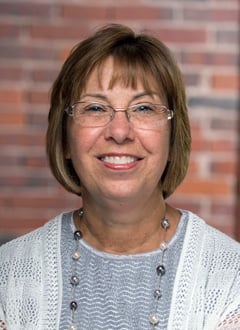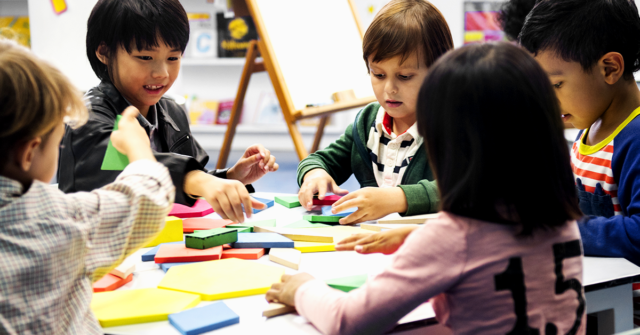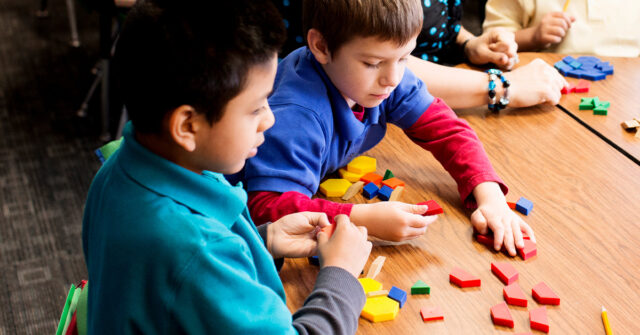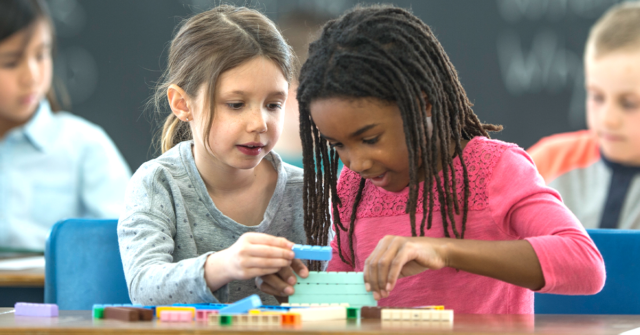
How do stories create space for mathematical thinking?
Today on the podcast we’re joined by Sue O’Connell, lead author of the Math by the Book series, and two of her co-authors Danielle Moore, and TJ Jemison.
Sue, Danielle, and TJ share their experiences utilizing children’s literature in the math classroom and provide strategies for integrating in seamlessly into existing curriculum. They began their conversation by discussing the benefits of using children’s literature in mathematics for grades 3-5.
Transcript
Sue: Well the first thing we think about, of course, is that stories immediately engage students. They pull them into the lesson. But one thing that I think is so important is that it shows them situations in which math appears in their lives. Some of the math topics in grades three to five like fractions, decimals, sometimes don't feel so relevant to students. So being able to show them situations in which the math appears in life can be really helpful for having them make sense of that mathematics.
TJ: Yeah. Well it's interesting, I get to travel around the country so I interact with students in New York City who don't know really maybe a lot about a farm or in Vermont who maybe don't know a lot about a city. And so having that common experience, I think, creates access and equity for students. So they're all working off of the same experience and building on what you said, that relevant connection to real life.
Danielle: I think in particular, these last few weeks I've been working a lot with fifth grade teachers and students. And as we go up in grades, a lot of the mathematical concepts like division and dividing fractions, become so abstract and so procedural that students don't see the connection to the real world. And the math and literature, the stories in math by the books theories, they really help students see that math is not just a series of numbers and procedures but it's something real that they can connect to and envision and make sense of.
Sue: And I think these stories naturally present problem situations. Because in the story, some events are happening or something happens with the character and it gets students talking and thinking and just naturally solving problems. So any time we can have that connection to problem-solving, that story context, I think that's a real bonus in our math classrooms.
TJ: Absolutely. Sue, just one other thing is that, I think teachers right now are under so much pressure and that time pressure. So if there's ways to integrate math and literacy and do some writing about math and some reading in math, I think that helps teachers to find a more efficient way to teach everything they have to teach.
Sue: Absolutely. Now one of the big questions I get from teachers is how do we decide which books are really good books to use in mathematics. So suggestions for picking children's literature. For me, the starting point is that I think about where would I see this math? When would I use this math? And then I look for books that might explore those situations. So for example, fifth graders are studying about volume.
So I think about when are times when you might have to think about volume? When volume might matter. And that lead me to, that thought about things like packaging boxes and size of packages, lead me to this wonderful book called the Crayon Man by Natascha Biebow. And it's the story, the true story, of the invention of the Crayola crayon. And along with the story of the trial and error and inventing this crayon, there were illustrations of the boxes and the weight, the packaging of the crayons which right away got me thinking about volume. How what size box would you need for eight crayons or sixteen crayons or twenty-four crayons. So I like to think about the mathematics, the math skill or concept. And then find a real situation that fits that.
TJ: So you can also think about a great story that you know students love and then think about what math can you bring out of that? A great example for me is Dragons Love Tacos. This is just a story that, the students I read this with were just eating it up. I mean they loved it. They just wanted to extend and do things with it. So in this book, the character is preparing lots of tacos for a party and he has all these dragons. And it just created this great context to think about adding and subtracting in multiples with multiple numbers. And even starting to play a little bit depending on the time of year with some multiplication and like three trays of 20 tacos, how many is that? The students I worked with really loved that and they just came up with some amazing work.
Danielle: The book Home: A Journey Through America, that was surprisingly a great book to use to think about distance and place value and deciding is there a real distance between ... Comparing the distance between New Jersey and New York to California and maybe Texas. I think it's a lovely story written by Thomas Locker where different authors use such powerful words and create such powerful images of their hometowns, really engaging for students. When I shared this book with students in fifth grade, they really leaned in and listened. And it inspired them to think about how they can describe their own homes and their own hometowns. So it's the unexpected but it works in powerful ways for students to really dive into the math. And I was excited about it.
I also think about, what books do you already have access to? What books might you already be using? There is math all around us. And if we're engaging with a book for shared reading or read aloud, could we also use that book to engage in mathematics?
TJ: I love that idea, Danielle. I think you could even get to a point where you ask your students. Like hey, we read this book. How could we extend it mathematically? How great for them to be the ones to bring the math forward.
Sue: So are there any other tips that you would give to teachers about making book selections?
TJ: For me, it's all about the fun factor. That's what I found as I brought books to read and to students and tried to extend some math activities. And the books that really captured students. So there's one I was a little skeptical about. It was called Can I Be Your Dog? by Troy Cummings. And that book's filled with all these letters written by a dog who wants to be adopted. And the students just, they loved it. And so pretty much anything I put in front of them to extend with math, they were just eating out of my hands. And so we went and did a bunch around perimeter and with that. And they just loved it.
Danielle: Definitely. And illustrations, right? They're so powerful and colorful. That's a great way to engage students and books and get them thinking about the math. Like you said, TJ, is it fun? Is there humor in the book? Themes, right? So maybe we think about Roberto Clemente and his biography. And maybe side by side about the struggle of migrant farm workers and how much do they get paid? How many hours do they spend in the field working? I like to think I can find math in just about any book and get students to engage with it and talk about it and look at mathematics from a different perspective.
Sue: And Danielle, I think those examples are so powerful because I think with grades three to five students, we want to look for stories that aren't as primary and that ... There are a lot of picture books out there that will really engage these students in some more challenging thinking and some more mature topics. Thinking about when we were talking about the idea of division with unit fraction divided by a whole number. And the book that we came up with was Born and Bred in the Great Depression. So it really was, it was written by Jonah Winter and it's a story of his family going through the Depression with lots of children and got me thinking about the children sharing. You know, if you had a half a cup of beans and three children had to share them, what's one half divided by three? How much are each of them going to get?
But it had that more mature theme to it. There are a lot of books with themes that are perfect for older students. Picture books, but with more mature themes to them. And they're still great jumping off points for math explorations. But what I love is that a lot of these books can also be jumping off points for discussion about social justice. We've found books related to sharing, related to kindness, related to caring for the environment. Or fighting for justice, like you mentioned side by side or overcoming obstacles. So many great themes and great books, pieces of literature, that work for math but are so much more than the math.
Danielle: I agree, Sue, definitely. You know I love that book, surprisingly, Born and Bred in the Great Depression. Because of their planting of vegetable garden, which reminds me of my grandparents. And there was a time of year where they would can the vegetables and can the fruit. So it's nostalgic for me but it's also thinking about, like you said, thinking about our environment and being environmentally conscious and how can we take care of what we have? So there's a lot, like you said, a lot of mature themes that you can dive deeper into and have great conversations about with upper grade students.
Sue: And I think that's so powerful that you say you loved it because it connected to something you knew. And it brought you back to thinking about your grandparents. And yet, there might be other students sitting right around that student in the math classroom who had never even heard of something like that. And that's that power of these books is that sometimes they really speak to individual students' experiences and other times, they share experiences the students were never exposed to and give them that opportunity to hear something so different from what their life might be like. And both of those are so valuable to have in our classrooms.
So as I've worked with schools, people often ask me, it's always that time issue. How do I fit children's literature into my existing math curriculum? So what suggestions would you give to teachers who want to try this but it's that, I don't know how to make this fit?
TJ: For me, it's really those brief tasks. Like a number sense routine that can be extended from the stories. So one of the books I've used is Mango, Abuela, and Me, by Meg Medina. And in this story, the main character's cooking with their grandmother and they're using a carton eggs. So taking an image of the carton of eggs and just showing it and extending that to be an array. And with the third-graders I worked with, it was so what do you notice here? And of course, they saw the additive six plus six or the six groups of two. But they even started to think about multiplication. So two groups of six or six groups of two. So I also think there's other problems you could extend from a story. So another book I read to students was Saffron Ice Cream by Rashin where a family's kind of traveling home to the beach and there could be word problems there about the miles they traveled on their journey, similar to what Danielle was saying earlier.
Sue: And again, back to bringing that context to the computations or the math skills and concepts that they're learning. Now they're doing it, there's maybe still adding three digit numbers but now, that has meaning. They're adding those miles that they've traveled.
TJ: And it's also kind of cross-referencing with measurement. So you're looking at different standards and different clusters or domains of the common core.
Danielle: Absolutely. I was thinking about what TJ said earlier, though. It's almost more efficient use of time if we think about what are we reading aloud in class? What are we writing about and how can we attach mathematics to what we're already focusing on? So if we're doing a read aloud and we're looking at themes, well where is math in that? So again, I agree with TJ 100 percent. It's a way to efficiently and be strategic about the time that is often so limited in the classroom. I also agree with you, Sue. I really appreciate this book on so many levels because it does apply context to numbers. They're not just abstract procedures on a paper or in a workbook. They are counting how many pounds of potatoes that might be pulled from a field. Or thinking about measurement and conversions, rather than mere calculations. So it's almost a more in-depth view of the mathematics. Instead of just numbers and operations, it's numbers, it's operations, it's procedures, but it's meaningful.
Sue: Right. It's a meaningful view of them, yes. Yes. And I think the other thing is, we're talking with teachers about fitting it into their curriculum. It's that reminder that these are working towards the same standards that your curriculum is working on. So we can insert a literature lesson along with or even in place of a curriculum task. We can replace a textbook lesson with a lesson from a story to get to the exact same math goal. And maybe to get to it with more meaning for students.
So TJ, you mentioned Can I Be Your Dog? Which is just such a fun story with the dog wanting to be adopted and does eventually get adopted. And then we explore the adopted mother wants to make a nice play yard. And what a fun way to explore perimeters of different sized yards and model them and explore and talk about, compare how much room the dog would have in these different yards, depending on how they're laid out. And just a perfect opportunity for students to see a real example of when they might want to be looking at the concept of perimeter. And for me, that's an example that kids are more likely to remember. We know all the confusion around perimeter, area, when we teach it in a textbook-based way. But when we do it through experiences and through stories, that's when I feel like kids are going to remember it. So there is nothing wrong with jumping out of the textbook for a little bit, doing a piece of literature. We're working towards the same goals, we're moving in the same direction.
TJ: Well and also, Sue, the math theoretically can work sometimes. But when you apply it to the context, we're talking about a yard for a dog, you're not going to make a yard that's one foot wide by eighteen yards. You know? So they can't turn around, they can run one direction. So it's again, bringing it back to that reality and relevant situations for students.
Sue: Absolutely. So could you share one final thought about using children's literature with intermediate level students? In those grade three to five classroom. What's one final thing you'd like to share with teachers?
Danielle: One of the things I appreciate is right now, I'm using Tia Isa Wants a Car with several fifth grade classrooms. And there are multiple opportunities for students to engage with mathematics. There's conversations where they're turning and talking with a partner and deciding on what would be the best procedure to use. There's opportunities for differentiation and support. So for students who might need a little bit more support getting up to date or ready for fifth grade level mathematical conversations, there's some support lessons there. There's some investigations, there's opportunities for students to read, write, and talk about the math. I feel, and the work I've been doing with these teachers is, we can teach a unit on adding and subtracting decimals just with math by the book. We haven't had to even open up the district curriculum textbook yet. Very thorough, it's very thorough.
TJ: I would just add to really just open your mind, think flexibly. Like we talked about earlier, you can find opportunities either to extend the math from a really great story or to find the math in a story and then you bring that story in because of the opportunity it provides. Having problem-solving situations, finding games to extend. We know that when students play and learn through play and playing a game, that they actually need fewer repetitions to actually solidify those concepts in their head. So any time we could bring in a game in, thinking about Hanukkah Bear and I played some dreidel games with students around multiples of five. And they just loved it. So that fun factor, so huge for me. Just having fun and I feel like every time I went into a classroom and showed the students that I was having fun. I was having fun with the story and then everything we did to extend it. They just ran with it and it was really ... It wasn't a hard sell at all.
Sue: No. And I think that's the most amazing thing is sometimes, we think, oh these fourth or fifth grade students, they're not going to want me to read a picture book to them. And then you go in there and do it and they love it. They are pulled right into it. And a lot of it is, like you said, TJ, when you love it, then they feel okay to love it, too. And they really get into the activity.
As we were putting together Math by the Book, one of the things that we were focusing on is that we wanted this to be more than just reading a book to kids and then doing a math lesson. We pulled literature into math class for a long time. But this is more than just reading a book. What we were looking for is rich math tasks where students begin with that story context but then they really learn the mathematics through it. They model ideas. They talk a lot. We ask deep questions. So it's building understanding of some sophisticated math ideas that are taught in grades three to five. Using literature in math class is fun and it should be fun. But, it isn't just fun. The story context is really perfect to get that deep learning started.
TJ: And I think it's great, Sue, I think this resource, Math by the Book, can be used anywhere at any grade level K to 5, as well as with any core curriculum. So it can supplement, it can add to enhance.
Danielle: You know one thing I learned during the pandemic is there are a lot of families and parents homeschooling their children. And I think that the Math by the Book is a phenomenal resource for families who are homeschooling their children. It's very rich, dive-in, definitely. It's a great recourse.
Sue: Definite opportunities too, just for intervention or enrichment kind of things. I think about summer school kind of things where you want to make the math fun because kids are coming in the summer and we want to make sure they're enjoying what they're doing. And again, what we're talking about is strong mathematics. But that is enjoyable and that begins with this context.
Well Danielle and TJ, I want to thank you for joining me to share your thinking about math in literature. It's been fun talking with you about what has become one of my favorite topics. So thanks for joining me today.
TJ: Always a pleasure, Sue.
Danielle: Absolutely. Thank you so much.
 Susan O’Connell has decades of experience supporting teachers in making sense of mathematics and effectively shifting how they teach. As a former elementary teacher, reading specialist, and math coach, Sue knows what it’s like in the classroom and her background is evident throughout her work as she unpacks best practices in a clear, practical, and upbeat way.
Susan O’Connell has decades of experience supporting teachers in making sense of mathematics and effectively shifting how they teach. As a former elementary teacher, reading specialist, and math coach, Sue knows what it’s like in the classroom and her background is evident throughout her work as she unpacks best practices in a clear, practical, and upbeat way.
Sue is the lead author of the new Math by the Book series, a K-5 resource connecting math and children's literature.
 Danielle Moore has over twenty years of experience working for diverse and urban school districts. As a classroom teacher, instructional coach, and currently as a mathematics consultant, Danielle works to ensure access to and equity in sound mathematical instruction for all.
Danielle Moore has over twenty years of experience working for diverse and urban school districts. As a classroom teacher, instructional coach, and currently as a mathematics consultant, Danielle works to ensure access to and equity in sound mathematical instruction for all.
 T.J. Jemison has extensive experience as a special educator, curriculum developer, and math coach. He is a dynamic workshop presenter and math consultant who facilitates professional development sessions across the United States and internationally and works with the All Learners Network.
T.J. Jemison has extensive experience as a special educator, curriculum developer, and math coach. He is a dynamic workshop presenter and math consultant who facilitates professional development sessions across the United States and internationally and works with the All Learners Network.


